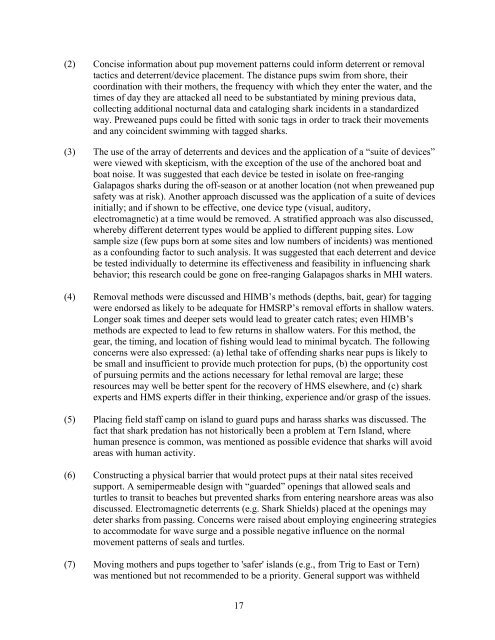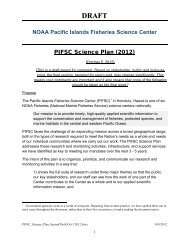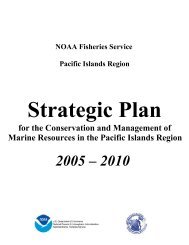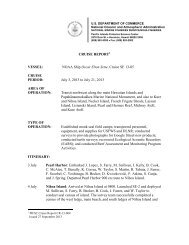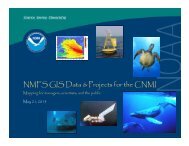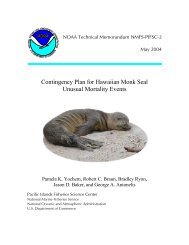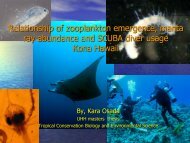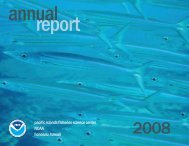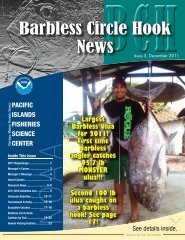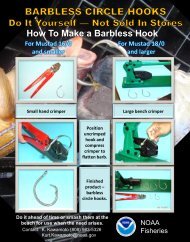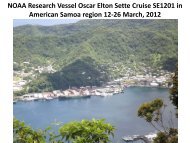Shark Predation on Hawaiian Monk Seals - Pacific Islands Fisheries ...
Shark Predation on Hawaiian Monk Seals - Pacific Islands Fisheries ...
Shark Predation on Hawaiian Monk Seals - Pacific Islands Fisheries ...
Create successful ePaper yourself
Turn your PDF publications into a flip-book with our unique Google optimized e-Paper software.
(2) C<strong>on</strong>cise informati<strong>on</strong> about pup movement patterns could inform deterrent or removal<br />
tactics and deterrent/device placement. The distance pups swim from shore, their<br />
coordinati<strong>on</strong> with their mothers, the frequency with which they enter the water, and the<br />
times of day they are attacked all need to be substantiated by mining previous data,<br />
collecting additi<strong>on</strong>al nocturnal data and cataloging shark incidents in a standardized<br />
way. Preweaned pups could be fitted with s<strong>on</strong>ic tags in order to track their movements<br />
and any coincident swimming with tagged sharks.<br />
(3) The use of the array of deterrents and devices and the applicati<strong>on</strong> of a “suite of devices”<br />
were viewed with skepticism, with the excepti<strong>on</strong> of the use of the anchored boat and<br />
boat noise. It was suggested that each device be tested in isolate <strong>on</strong> free-ranging<br />
Galapagos sharks during the off-seas<strong>on</strong> or at another locati<strong>on</strong> (not when preweaned pup<br />
safety was at risk). Another approach discussed was the applicati<strong>on</strong> of a suite of devices<br />
initially; and if shown to be effective, <strong>on</strong>e device type (visual, auditory,<br />
electromagnetic) at a time would be removed. A stratified approach was also discussed,<br />
whereby different deterrent types would be applied to different pupping sites. Low<br />
sample size (few pups born at some sites and low numbers of incidents) was menti<strong>on</strong>ed<br />
as a c<strong>on</strong>founding factor to such analysis. It was suggested that each deterrent and device<br />
be tested individually to determine its effectiveness and feasibility in influencing shark<br />
behavior; this research could be g<strong>on</strong>e <strong>on</strong> free-ranging Galapagos sharks in MHI waters.<br />
(4) Removal methods were discussed and HIMB’s methods (depths, bait, gear) for tagging<br />
were endorsed as likely to be adequate for HMSRP’s removal efforts in shallow waters.<br />
L<strong>on</strong>ger soak times and deeper sets would lead to greater catch rates; even HIMB’s<br />
methods are expected to lead to few returns in shallow waters. For this method, the<br />
gear, the timing, and locati<strong>on</strong> of fishing would lead to minimal bycatch. The following<br />
c<strong>on</strong>cerns were also expressed: (a) lethal take of offending sharks near pups is likely to<br />
be small and insufficient to provide much protecti<strong>on</strong> for pups, (b) the opportunity cost<br />
of pursuing permits and the acti<strong>on</strong>s necessary for lethal removal are large; these<br />
resources may well be better spent for the recovery of HMS elsewhere, and (c) shark<br />
experts and HMS experts differ in their thinking, experience and/or grasp of the issues.<br />
(5) Placing field staff camp <strong>on</strong> island to guard pups and harass sharks was discussed. The<br />
fact that shark predati<strong>on</strong> has not historically been a problem at Tern Island, where<br />
human presence is comm<strong>on</strong>, was menti<strong>on</strong>ed as possible evidence that sharks will avoid<br />
areas with human activity.<br />
(6) C<strong>on</strong>structing a physical barrier that would protect pups at their natal sites received<br />
support. A semipermeable design with “guarded” openings that allowed seals and<br />
turtles to transit to beaches but prevented sharks from entering nearshore areas was also<br />
discussed. Electromagnetic deterrents (e.g. <str<strong>on</strong>g>Shark</str<strong>on</strong>g> Shields) placed at the openings may<br />
deter sharks from passing. C<strong>on</strong>cerns were raised about employing engineering strategies<br />
to accommodate for wave surge and a possible negative influence <strong>on</strong> the normal<br />
movement patterns of seals and turtles.<br />
(7) Moving mothers and pups together to 'safer' islands (e.g., from Trig to East or Tern)<br />
was menti<strong>on</strong>ed but not recommended to be a priority. General support was withheld<br />
17


